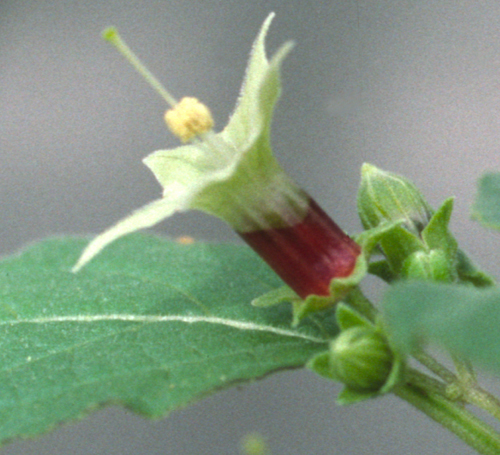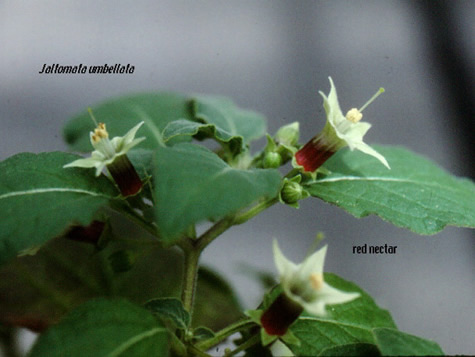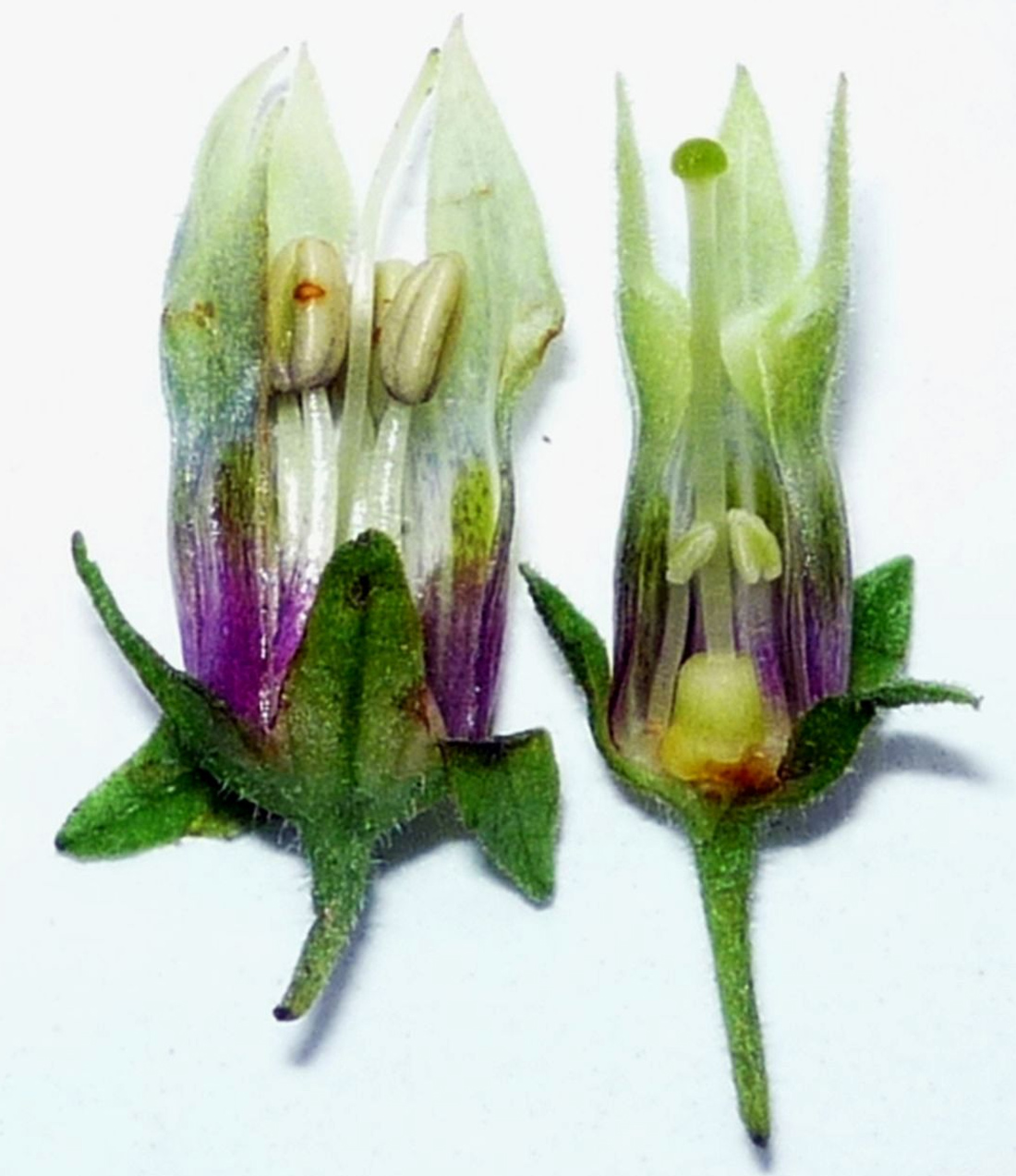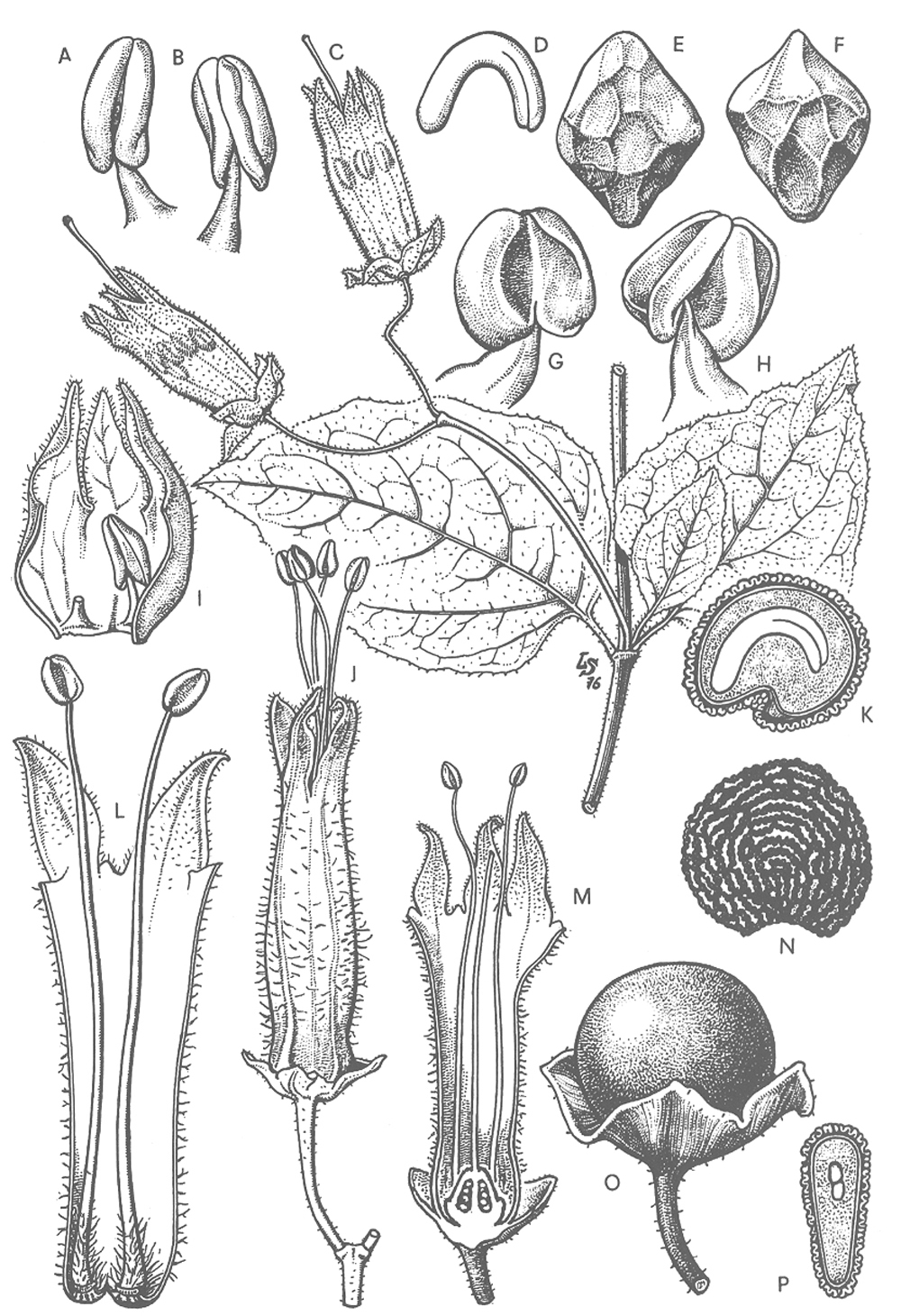Jaltomata umbellata (Ruiz López & Pavón) Mione & M. Nee |
Peru |
revised July 2021 |
| Link to Jaltomata homepage | The information on this page may be cited as a communication with professor Thomas Mione, Central Connecticut State University, Biology Department, Copernicus Hall, 1615 Stanley Street, New Britain, CT 06050-4010 USA |
Link to the Jaltomata of department Lima, Peru |
Link to the Jaltomata of lomas formations |
Link to Jaltomata having red / orange nectar |
Link to chromosome count |
| Figure 1. Inflorescence of Jaltomata umbellata. The red "juice" in the flower is red nectar! Photo by Jamie Kostyun, Mione 432. |
|---|
 |
 |
Figure 2. Red nectar shows through the corolla tube (Mione 432, photo by T. Mione) |
Figure 3. Flowers of Jaltomata umbellata |
Jaltomata umbellata (Ruiz López & Pavón) Mione & M. Nee. Hebecladus turneri Miers, London J. Bot. 4: 323. 1845. TYPE: Without locality, evidently from a cultivated specimen fide Miers, D. Turner s.n. (HOLOTYPE: K!). |
|---|
| Character | Description | Figures on this page |
Habit & Height |
Shrub to 1.3 m | |
Branches, young |
pilose, the hairs long, soft, mostly finger-like, sometimes with both gland-tipped finger hairs and shorter non-glandular dendritic hairs interspersed among each other | |
older |
terete in cross section | |
Leaves, size |
blades less than 11 cm long and 8 cm wide. | 2, 3, 10 |
| shape | blades typically entire; ovate, the apex acute. | |
| hairs | young leaves pilose, the hairs long, soft, finger-like | |
| petiole | ||
Inflorescence |
4-9 flowered |
1 |
peduncle |
4.5-11 mm long | |
pedicel |
6-9 mm long, densely hairy, with clear droplets terminating all the haris (gland-tipped finger hairs) | |
Calyx at flowering |
8-9 mm diam.; lobe radius 4-5 mm long; sinus radius 2 mm long. Lobes of calyx triangular to narrowly triangular. Abaxial face of calyx bearing both gland-tipped finger hairs and shorter, non-glandular dendritic hairs interspersed among each other. | |
| shape / position when flowering | concavely subrotate | |
| at fruit maturity | calyx-lobe radius 6-8 mm | |
Corolla color |
cream or pale-green; remaining open at night. | |
shape and size |
Tubular with a broad limb. The tube 4 mm diameter X 6.5-8 mm
long, partially to nearly completely filled with red nectar. Lobes narrowly triangular. |
|
lobes / lobules |
no lobules (field-collected 623) | |
hairs
|
inner face of cor lobes having erect gland-tipped finger hairs | |
Stamen length including anther |
(including expanded base) 9.2-10.9 mm | |
| length stamens exserted beyond distal end of corolla (applicable if corolla has a well-defined tube) | up to 7 mm | |
| no (Mione 623, July 2021, No radial thickenings!) | 7 | |
| base expanded laterally? | yes | 7, 8, 9 |
| filaments | slender part with a few to several finger trichomes to 0.5 mm long on basal 1/4-1/3 of the length | |
| anther color | yellow | |
| anther size | undehisced 1.9-2.1 mm long X 1.4-1.5 mm wide |
|
| anther mucronate/mucronulate | No | 432 & 623 were examined |
| insertion of filament into anther | ||
| anthers of a flower open simultaneously? | No, "Anthers typically dehisce in the morning, although not all at once, and occasionally one or two anthers within a flower remain undehisced into the afternoon." | Observation by Jamie Kostyun, cultivated plants of Mione 432 |
| pollen grain size | ||
| corona | No | |
Stigma |
pale-green, exserted beyond anthers up to 8 mm but sometimes not; overhead dimensions 0.46-0.56 mm by 0.4-0.46 mm; often protruding through the otherwise closed corolla prior to anthesis, not bilobed | |
Style |
8-13.3 mm long, dull-white, 0.29 mm diam at midlength |
|
Ovary |
pale-green, the disk orange | |
Nectar |
red (observations made both in the field and in the greenhouse) | 1, 2, 3 |
| Herkogamy | Yes | 2, 3 |
| Protogyny | ||
Fruit color (at maturity) and size |
orange in greenhouse | |
Seeds per fruit |
to 63 | (n = 3 fruits on plant grown in CT, 432) |
Seed Size |
1.36-1.48 mm long (field collected) | |
Self-Compatible? |
yes, at least occasionally self-sets fruit in greenhouse | |
| Character | Description of Jaltomata umbellata | Figures on this web page |
| Character | Description | |
Growability in Connecticut, USA |
not difficult | |
How long does it take from flower to ripe fruit? |
no data | |
Flowers Closing For The Night? |
No | Jamie Kostyun agrees, personal communication |
Self-Compatible? |
yes, at least occasionally sets fruit in pollinator-free greenhouse | |
Seed Germination |
9 to 14 days, explained below | |
| Pollen quantity per flower | 47,813 - 53,750 | (n = 3 flowers, 432) |
Ovules per ovary |
70-78 | (n = 3 flowers, 432) |
Ratio of pollen to ovules |
616 - 746.5 | (n = 3 flowers, 432) |
Chromosome number |
2n = 24 (Diers, 1961); n = 12 (meiosis of anthers from plants from seeds of Chavez s.n.). |
|
| Character | Jaltomata umbellata |
| Province | Locality | altitude m | habitat | date | collector |
|---|---|---|---|---|---|
| presumably Chancay | TYPE SPECIMEN: "Chancay, Limae et Lurin" The book "Travels of Ruiz Pavón and Dombey in Peru & Chile" also mentions this species growing in Lurin. |
no data |
no data |
no data |
Dombey s.n. (P!) |
| Chancay | Lomas de Lachay | 650 |
debajo de peñas |
14 Jul 1948 |
R. Ferreyra 3861 (US) |
| Chancay | Lomas de Lachay | 400-450 |
arcilloso-arenoso |
23 Sep 1959 |
R. Ferreyra 13797 (G) |
| Chancay | Lomas of Lachay, 105 km N of Lima on Panamerican Hwy | 300-500 |
lomas |
15 Oct 1983 |
M. O. Dillon et al. 3626 (BH NY US) |
| Chancay | 105 km N of Lima on PanAm Hwy, then drive west into Reserva Nacional de Lachay | 480 |
lomas |
16-17 Jan 1998 |
T. Mione, S. Leiva G. & L. Yacher 623 = S. Leiva G., T. Mione & L. Yacher 2131 (HAO) |
| Chancay | 11 21 30 S, 77 22 11 W | 478 |
lomas, next to boulder an open hillsides |
15 June 2005 |
T. Mione, S. Leiva G. & L. Yacher 730, photos and DNA only, no pressed specimen |
| Chancay | Lomas del Lachay, 80 km N of Lima on Pan-American Highway, 11 20' S, 77 30' W | 400 |
lomas |
1 Sep 1991 | A. Gentry et al. 74517 (NY) |
no data |
Sandy hills of Lachay-Lima | dry and hot desert | R. Chavez s. n. [herbarium specimen not seen; photos on this web page were taken of plants grown from the seeds of this collection, grown as Mione 432] | ||
| Huaral | Lomas de Granados | lomas | Cuba-Melly & Odar (2018) | ||
| Huaral | Lomas de Granados | 300 - 450 |
lomas |
26 Aug 1950 | C. Vargas C. 9558 (CUZ) |
| Lima | handwriting unreadable: this specimens seems to have been collected near Lima | no data |
lomas, based on my experience, not given on specimen label |
1876 | Campagne de la Magicienne; collection number difficult to read, possibly 1573 (K) |
| Lima | Atacongo Lomas, 32 km S of Lima, 8 km east of Pachacamac Ruins | 400 |
lomas |
27 Sept 1938 | H. E. Stork, O. B. Horton & C. Vargas 9294 (GH, K) |
| Lima | Lomas de Atocongo | no data |
lomas |
10 Nov 1946 |
O. Velarde Nuñez 212 (US) |
| Lima | Amancaes | lomas, based on label data of other specimens collected at same locality |
Aug 1912 |
55 (K) | |
| Lima | Amancaes | lomas, based on label data of other specimens collected at same locality |
Mathews 722, listed by Miers in Illustrations of South American Plants. | ||
| Lima | vicinity of Lima, San Agustín | 350 |
lomas, based on label data of other specimens collected at same locality |
July 1909 |
A. Weberbauer 5223 (NY US) |
| Lima | vicinity of Lima, San Agustín | 350 |
Loma-formation |
July 1909 |
A. Weberbauer 5228 (US) |
| Lima | vicinity of Lima, San Agustín | loma |
27 Sep 1940 | E. Asplund 13776 (G US) |
Macbride (1962) incorrectly listed this species as growing in Peru's department Amazonas.
| Seeds germinated in only 9 days after being stored in the refrigerator for about 15 years! These were planted in cups of moist potting mix on a sunny window sill on 14 Apr 2007 and the first seed germinating was noted on 23 Apr 07. I kept seeds consistently moist (nearly wet for the first few days) and used a plug-in mat that provides mild heat underneath. The 2007 seeds were collected from three different plants grown from the original seeds, planted as follows. In 1989 seeds germinated in 14 days. These seeds were planted on 13 Aug 1989 and the first seed geminating was noted on 27 Aug 1989. At this writing (2007) I can't recall exactly how I germinated seeds back then, but I don't think I used a heat mat underneath, and the seeds were probably in a mist room until they germinated. My seeds per fruit data for this species is dated March 1992, so the 2007 seeds that germinated were very likely from the seeds counted in March of 1992. |
| All perfectly straight, unbranched, uniseriate, droplet-tipped (gland-tipped), clear (unpigmented). Length highly variable, from 0.06 mm long to 3.04 mm long. If I look at the hairs with a dissecting scope, and touch something to the tip of the hair while looking, I can see that the substsance at the tip of the hair is viscous (observations made 5 May 2007). |
 |
| Figure 4. Possible gynodioecy. These floral morphs were found on two different plants near each other. Functionally hermaphroditic flowers (left) have much larger anthers and a smaller stigma than the functionally pistillate flowers (right). If the flower at left is actually functionally staminate then dioecy, not gynodioecy, would be the case. The ovaries of the two morphs are similar in size. Photograph and information generously provided by Carlos Martel, Museo de Historia Natural, UNMSM-Lima (Mione has seen similar situations in J. diversa, J. lanata 741, J. lojae 813, J. sagastegui 755, and J. truxillana). |
| Figure 5. Inflorescence of Jaltomata umbellata. The red "juice" in the flower is red nectar! Photo by Jamie Kostyun, Mione 432. |
| Figure 6. Jaltomata umbellata. Base of flower showing base of androecium. Mione 432, photo by T. Mione |
| Figure 7. Jaltomata umbellata. Base of flower showing laterally (not radially) expanded base of stamens. Mione 432, photo by T. Mione |
| Figure 8. Jaltomata umbellata. Base of stamen is laterally (not radially) expanded. Mione 432, photo by T. Mione | Figure 9. Jaltomata umbellata. Dorsal view of base of stamen. Base is laterally (not radially) expanded. Vertical black lines at base are 1 mm apart, the edge of a ruler. Mione 432, photo by T. Mione |
 |
 |
Figure 10. The above figure and caption are from Huziker (2001) page 195. The specimen selected to be used for the drawing of J. umbellata is listed above as one of the specimens I examined. |
| Acknowledgements: Sandra Ek taught me how to grow, and helped care for, the plants shown in figures 2 & 3 (in the early 1990s). Gregory J. Anderson and Gabriel Bernardello provided the environment conducive to the birth of this project. Rene Chavez sent to Tilton Davis IV seeds of J. umbellata and T. Davis generously passed the seeds on to me, and these were grown, allowing the top two photos. |
Photos by Mione of specimens borrowed from and then returned to P.